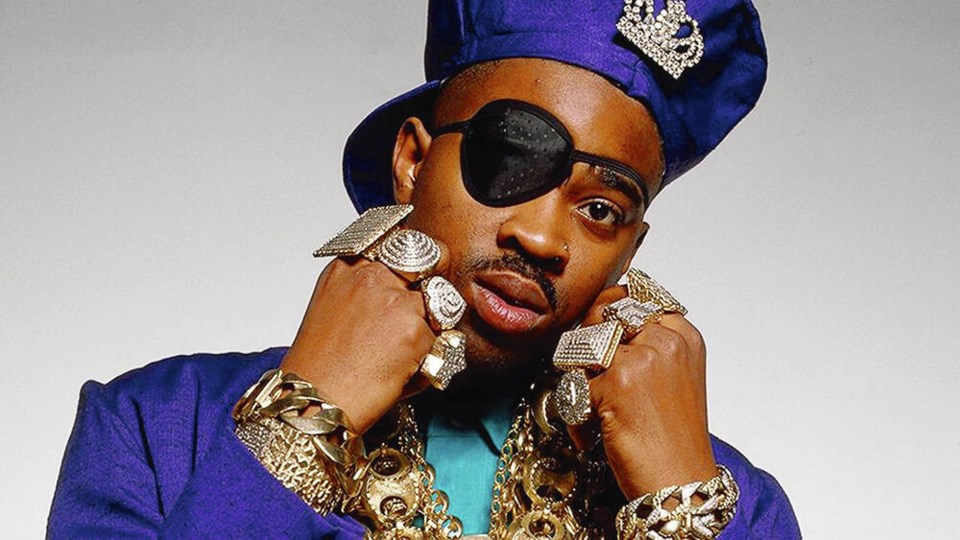SLICK RICK
With: DJ Anger, Degree One, and Prevail
Where: Capital Ballroom, 858 Yates St.
When: Thursday, May 9, 9 p.m.
Tickets: $75.39 from thecapitalballroom.com
When rap music raised its profile in the late 1970s, its lyrical content was spare and production values minimal. But when the genre began expanding its reach in the mid-’80s, outliers began to emerge.
From artists who specialized in beatboxing (Biz Markie) to ones who went for cartoonish laughs (DJ Jazzy Jeff & the Fresh Prince), it was a wild era for the genre. And few from that time period cut a more distinguishable shadow — in and out of the studio — than Slick Rick, the most successful British-American rapper in history.
Born in London, England, and raised in the Bronx, the rapper came to prominence at 19 years-old as MC Ricky D in Doug E. Fresh’s Get Fresh Crew. He was a featured player on The Show and La Di Da Di, two groundbreaking 1985 singles by the group, whose sheer ingenuity altered the course of hip-hop.
“This was one of those ‘a star is born’ moments in hip-hop,” Questlove from The Roots wrote in Rolling Stone magazine. “Rick is full of punchlines, wit, melody, cool cadence, confidence and style. He is the blueprint. No one bragged like him, no one name-dropped like him, no one sang like him, no one was funny like him. Nobody.”
The songs were game-changing for the performer born Ricky Walters, who soon changed his name to Slick Rick. He was signed to a solo contract by Def Jam co-founder Russell Simmons, which led to the release of his groundbreaking 1988 debut, The Great Adventures of Slick Rick. The record sold 1.2 million copies by 1991, a remarkable feat for a niche album by a talent largely unknown outside of rap circles.
This is where the real life adventure begins. In 1990, Walters went to prison for attempted murder, after firing six shots at his cousin. He claimed it was in self-defense, but pled guilty to the charges (in 2008, he was pardoned by then-New York Governor David Paterson for his role in the shooting). His career would never recover from the six-year bid. He recorded 1991’s The Ruler’s Back while on bail and prior to being convicted, and his third album, 1994’s Behind Bars, was pieced together while he was in prison.
Neither album made much of an impact. “I thought they were garbage. Rushed,” Walters later told Insomniac magazine. “It’s something I would not have released to the public like that.”
Out of prison in 1997, he returned to the studio and received high praise for 1999’s The Art of Storytelling, which included collaborations with Nas, Snoop Dogg, and Outkast. To date, he has not yet released a follow-up, despite being one of the most sampled hip-hop artists in history. “I have a studio in my house, so I play around a lot,” he told Rolling Stone in 2016.
“Just as a hobby, because I enjoy it. It was never really a job to me; it was more like a hobby.”
Part of his difficulties stemmed from immigration issues, pertaining to his citizenship. He was granted his U.S. citizenship in 2016 after 23 years of legal headaches, including the threat of deportation due to his criminal record.
Which is why he’s making his Victoria debut tonight, and not several decades ago. He performed in Toronto for the first time in January, so he’s clearly making up for lost time.
“I still have energy, and if you’ve got the energy you want to release it,” Walters told Bevy Smith in a YouTube interview. “When you see your community and your culture not living in up to a certain status, a certain bar, you want to maintain that bar. [I’m] not yet dead yet.”
Upon arrival, he stood apart. He wore an eyepatch, due to a childhood injury which cost him his right eye; he was also one of the first stars in hip-hop to sport gold teeth, Kangol berets and flamboyant, brightly-coloured suits. Most rap acts in the ’80s wore track suits or sports-themed mechandise. Slick Rick rapped about Polo cologne and Gucci underwear, while wearing Bally shoes, Wallabee boots, cardigan sweaters, and fur-collared trench coats.
The British influence was front and centrer, Walters recalled in an interview with Wonderland magazine of the UK, which he left for the U.S. at 11 years old. “I felt like kids were a lot cooler than I was so I had to step my swag up. I had an accent, I was different. You find friends in school eventually though, if you like the same things or share the same culture and have similar backgrounds, you know?”
Three landmark singles — Children’s Story, Hey Young World, and Teenage Love — sent The Great Adventures of Slick Rick Rick to the No. 1 spot on Billboard’s R&B/Hip-Hop Chart in 1988, and offered something far more complex that the streetcorner braggadocio of his peers. Perhaps overlooked at the time, Slick Rick has been the recipient of much acclaim in recent years. The Source magazine placed him at No. 15 on its list of the Top 50 hip-hop lyricists of all time, while Spin magazine ranked Children’s Story as the second-best hip-hop single of the 1980s, behind 1982’s The Message from Grandmaster Flash and the Furious Five.
He also participated in Fresh, Fly, and Fabulous: Fifty Years of Hip-Hop Style, a 2023 exhibit at New York’s Fashion Institute of Technology, and is now a member of the Bronx Walk of Fame.
His voice, however, remains his signature. “Slick Rick’s voice was the most beautiful thing to happen to hip-hop culture,” Questlove from The Roots wrote in Rolling Stone. “It’s clear that no one will ever, ever sound like him.”



